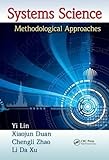Systems science [electronic resource] : methodological approaches / Yi Lin ... [et al.].
Material type: TextSeries: Advances in systems science and engineeringPublication details: Boca Raton : CRC Press, 2013.Description: xx, 379 p. : illISBN:
TextSeries: Advances in systems science and engineeringPublication details: Boca Raton : CRC Press, 2013.Description: xx, 379 p. : illISBN: - 9781439895528 (ebook : PDF)
- Also available in print edition.
Includes bibliographical references (p. 359-367) and index.
ch. 1. A brief history of systems science -- ch. 2. Concepts, characteristics, and classifications of systems -- ch. 3. Nonlinear systems dynamics and catastrophe -- ch. 4. Self-organization : dissipative structures and synergetics -- ch. 5. Chaos -- ch. 6. Fractals -- ch. 7. Complex systems and complexity -- ch. 8. Complex adaptive systems -- ch. 9. Open complex giant systems -- ch. 10. Complex networks -- ch. 11. Case studies.
"Preface It was in the year 1978 when Mr. Chi Xu published his head-turning reportage, entitled The Goldbach Conjecture, that Chinese people with great national enthusiasm learned about Jingrun Chen, a mathematician, and his life-long attempt to prove the problem of 1 + 1 = 2, a shining star on the mathematical crown. However, as of the present day, the public is still not adequately acquainted with systems science and the fundamental idea behind 1 + 1 > 2. Within the landscape of modern science, at the same time when disciplines are further and further refined and narrowed, interdisciplinary studies appear in abundance. As science further develops and human understanding of nature deepens, it is discovered that many systems interact nonlinearly with each other and do not satisfy the property of additivity. Their emergent irreversibility and sensitivity cannot be analyzed and understood by using the methodology of the traditional reductionism. Facing this challenge, systems science appeared in response of time. The most fundamental characteristic of this science is the concept of "emergence": The whole that consists of a large number of individuals that interact with each other according to some elementary rules possesses some complicated properties. That is, the whole is greater than the sum of its parts (1 + 1 > 2). The basic tasks of systems science are the exploration of complexity and the discovery of elementary laws that govern complex systems of different kinds so that by making use of the principles of systems science, one can explain many complicated and numerous matters and events of the kaleidoscopic world and provide different control mechanisms"-- Provided by publisher.
Also available in print edition.
Mode of access: World Wide Web.
There are no comments on this title.


